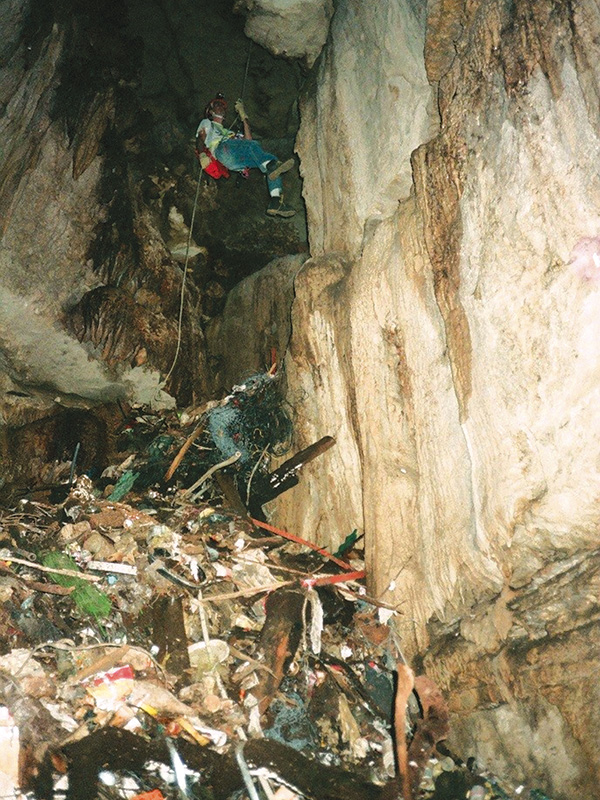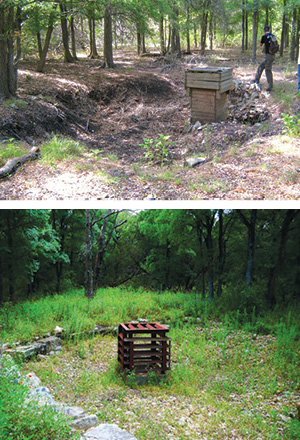The Cricket Connection
You might be surprised to learn that, as recently as 1994, Wildflower Cave — which sits in the middle of the Center’s Savanna Meadow — was filled to its ceiling with trash. And nearby La Crosse Cave was filled with soil, rock and fencing wire. In fact, before the public began recognizing the value of caves and their part in recharging groundwater, widespread filling — coupled with limited restoration efforts — covered up many caves in the Austin area.
Caves are naturally widespread across the Edwards Plateau but are most concentrated in the Edwards Aquifer recharge zone (which includes Wildflower Center land). Local cave explorers mapped over 160 Austin-area caves from the 1950s to the ’80s, the vast majority of which required excavation and, in some cases, trash removal. Some caves were filled naturally with clay-rich sediment during a very wet period following glaciation across North America. These are often rich in paleontological and archeological treasures dating to 20,000 years old — including remains of large mammals such as saber-toothed cats, mammoths, camels, giant sloths and glyptodonts (large, extinct relatives of armadillos).
However, the vast majority of caves were filled within the last 200 years. Early pioneers and ranchers heavily modified the landscape to keep water at the surface for stock ponds, pre-air-conditioning cooling, water supply and mill operations. Caves were commonly utilized for trash disposal. They were also filled to prevent livestock from falling in and to keep people out. Furthermore, logging and overgrazing contributed to serious soil erosion which washed directly into caves. On lands intended for future development, caves were filled in to increase marketability.

A caver rappels into trash-filled Midnight Cave, located on the original Circle C Ranch property. This cave was used as a trash dump once Wildflower Cave was full. PHOTO Nico Hauwert
This widespread filling increased local flooding risk and reduced recharging of groundwater that supports endangered aquatic life, water-supply wells and treasured springs. Wildlife such as bats were excluded from their natural habitat and sought refuge in attics, bridges, stadiums — even Austin’s original city hall. Originally viewed as a blood-sucking, rabies-spreading pariah, bats benefited from the hard work of biologists such as Merlin Tuttle and Bat Conservation International and are now an Austin mascot and major tourist attraction.
Like bats, animals such as bobcats, ringtails, raccoons, Virginia opossums, porcupines, vultures, snakes, frogs, toads and cave crickets still seek refuge in caves and can play a vital role in bringing nutrients to deeper troglobitic (cave-bound) life, including rare and endemic invertebrates.
Restoring cave habitats involves more than removing sediment and trash however. It requires revegetation. Tree and shrub canopies are vital in cave restoration for stabilizing steep entrance slopes, retaining moisture by minimizing evaporation, creating favorable conditions for cave crickets (Ceuthophilus spp.), and reducing red imported fire ant habitat — all of which greatly improve habitat for cave-dwelling species.
Two keystone species of cave crickets, Ceuthophilus secretus and Ceuthophilus sp. B, forage outside of caves and, because a healthy population for one cave can number in the thousands, have the potential to bring large amounts of vital nutrients into otherwise nutrient-poor cave systems. Cave crickets’ primary diet is plants, so improving native plant diversity — with a particular emphasis on shrubs and trees that produce pulpy fruit — is key. Supportive native species include Texas persimmon (Diospyros texana), Ashe juniper (Juniperus ashei), Mexican plum (Prunus mexicana), agarita (Mahonia trifoliolata), rusty blackhaw (Viburnum rufidulum), Texas mulberry (Morus microphylla) and Carolina buckthorn (Frangula caroliniana).
Native grasses, sedges and forbs can also be planted to stabilize the soil, but these should be limited to shade-tolerant species such as inland sea oats (Chasmanthium latifolium), Buckley’s fluffgrass (Tridens buckleyanus), cedar sedge (Carex planostachys) and cedar sage (Salvia roemeriana). All of these reduce habitat for biodiversity-decreasing fire ants, which prefer open, disturbed sites.

TOP Winter Woods Cave in William H. Russell Karst Preserve in Southwest Austin. The ground surface was once nearly flush with the top of the wooden structure. Note the role of tree roots in stabilizing the soil. PHOTO Nico Hauwert BOTTOM Winter Woods Cave five years after restoration began. Trees and shrubs were planted to replace those removed during excavation. PHOTO Drew Thompson
Native plants were critical to the successful restoration of Wildflower Cave, the aforementioned mid-’90s trash heap. Thanks to the collaborative cleanup efforts of the Underground Texas Grotto, the City of Austin and the Wildflower Center, combined with native plant revegetation and maintenance, Wildflower Cave has been a significant destination for youth education since 2002, sometimes hosting as many as 2,000 students per year.
The restoration of nearby La Crosse Cave tells a similarly positive story: Prior to excavation, no troglobitic species were observed; the ecosystem consisted of surface species such as assassin bugs, earwigs, booklice, surface spiders and only a small population of cave crickets.
Post-excavation and revegetation, the cave has a very healthy cave cricket population — which has made conditions more favorable for troglobitic cave fauna. On the most recent survey, cave biologists observed rare species such as cave-adapted millipedes (Cambala speobia), eyeless meshweaver spiders (Cicurina bandida), ground beetles (Rhadine austinica) and harvestmen (Texella mulaiki). Staff also observed healthy populations of cliff chirping frogs (Eleutherodactylus marnockii) and western slimy salamanders (Plethodon albagula).
Just this year, five tricolor bats (Perimyotis subflavus) sought refuge in Wildflower Cave for hibernation — a great manifestation of the power of habitat recovery.
Wildflower and La Crosse Caves are open for exploration during Austin Cave Festival, an event organized by the Barton Springs Edwards Aquifer Conservation District and the City of Austin and held at the Wildflower Center every February.
Find opportunities to go underground with the Barton Springs Edwards Aquifer Conservation District or Underground Texas Grotto. Sign up to help with revegetation restoration efforts here.
Dr. Nico Hauwert and Mark Sanders work as program manager and biologist, respectively, for the Balcones Canyonlands Preserve. They have been involved in studying and restoring life in Central Texas caves for decades.

